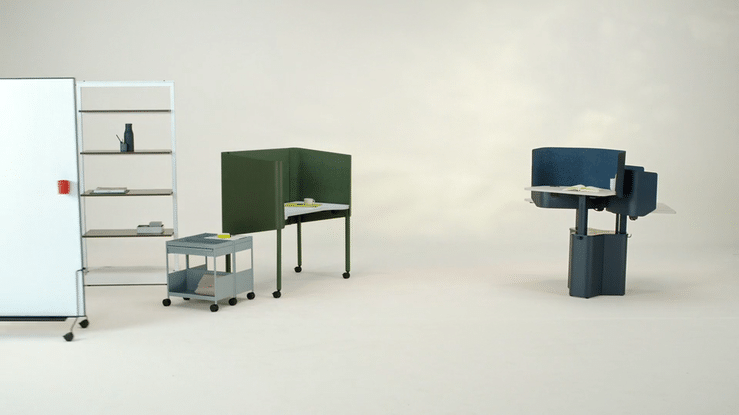COVID-19 may not have made any 2020 prediction lists, but it certainly is leaving an impression on how companies and individuals will work in the future. With vaccines rolling out globally, infection rates dropping, and local governments beginning to increase the occupancy of everything from local parks to restaurants, CEOs around the world are looking for new office solutions to fit the future of work.
Herman Miller, who has been at the forefront of every major workplace advancement (yes, even the cubicle), has devoted thousands of hours working with companies of every size trying to help them navigate the pandemic and prepare for post-pandemic work environments. This research confirmed what Herman Miller workplace strategists predicted pre-pandemic—organizations were craving holistic solutions that took on all of the challenges that come with designing meaningful workspaces for the present, while simultaneously setting them up for success in an uncertain, fast-changing future.
Enter the OE1 Workspace Collection. OE1 is the latest in a line of office products that embraces the unpredictability of the future by landing squarely at the crossroads of agility, functionality, and modularity. OE1 offers a wide range of items that can be used to create highly varied work settings yet are flexible enough to adapt to growth, new needs or desires, or even the unexpected—like a global pandemic.
OE1 Storage Trolleys nest nicely under OE1 Rectangular Tables, or other tables in the workplace.
“While this project was started prior to the pandemic, our research over the last year has only intensified our belief in the relevance of this line,” says Ryan Anderson, Vice President of Global Research and Insights at Herman Miller. “With people forced to work outside of offices, traditional means of workplace planning have been challenged by the unpredictability of how people will work now and in the future. These changes will continue, and workspaces need to constantly adapt. Workers are ready for a greater degree of variety, choice, and control—people want their environments to work for them, and OE1 is designed to enable that.”
A collection of essential pieces that span mobile tables, movable walls, height-adjustable workstations, storage trolleys, and more, OE1 directly responds to how and where people want to work, encouraging a reexamination of traditional workplace design while allowing employees to build, test, and recreate their spaces. By enabling people to experiment with space, employees will gain confidence as they can not only discover solutions needed in the now but also adjust rapidly if needed. OE1 mitigates the risk of an uncertain future for organizations yet empowers employees to create optimal spaces to suit their work.
OE1 puts the power of workplace reconfiguration in the employees’ hands,” says Malisa Byrant, Senior Vice President and General Manager of Global Workplace at Herman Miller. “This is a huge benefit for both the organization and the employees. For the organization, it provides a high degree of assurance that their workspaces will remain productive, relevant, and desirable over the life of the building without spending vast sums on facility reconfigurations. For the employee, it signals that the space is in service to them – that it exists to facilitate their desired work processes so that they can have greater control and achieve their goals. Real estate is highly static, but work can change quickly. OE1 was designed to bridge the difference in clock speed between work and the workplace to help organizations succeed in a new era of work.”
OE1 was created in partnership with designers Sam Hecht and Kim Colin of Industrial Facility. With a goal of understanding the physical and cultural changes that had started to take shape surrounding the future of work, the team made visits around the world to understand the entire industry ecosystem. Identifying these signals of the future, Sam and Kim carefully crafted the suite of products available in the OE1 Workspace Collection.
“One thing we noticed is that day one, the furniture is installed—and day two, things need to be changed. When you zoom out to a macro view, you become aware of the magnitude and pace of ongoing change. So OE1 is more like an un-system – it's playing by different rules that address these scalar changes,” says Sam Hecht.
“OE1 offers choice, is flexible, and can adapt so that individuals (not just organizations) get to experience these qualities directly,” says Kim Colin. “Our challenge was to invent something completely new while also making it recognizably useful. OE1 is designed so that everything is having a conversation with each other, and the conversation is healthy."
Used as individual pieces or the entire collection, OE1 seamlessly integrates into existing spaces or can be used to create entirely new ones, enabling organizations to create new facilities or strategically improve existing ones for post-pandemic working. Companies of any size will find that OE1 offers greater agility and better workplace experiences. From the organization as a whole all the way down to a team or individual, OE1 creates flexible, fluid environments that can easily adapt to shifting goals and personal preferences. With tables that can easily be pushed together or broken apart, flexible walls that divide space and create boundary, and a myriad of other adaptable OE1 products, each one was created with key details specially designed to help spaces meet any number of needs without permanence or rigidity. Above all, OE1 aims to give peace of mind that whatever comes (expected or unexpected) investments have been made in solutions that can quickly shift and adapt with minimal interruption.


